Numerical Solution of Transition to Turbulence over Compressible Ramp at Hypersonic Velocity
Abstract
:1. Introduction
2. Governing Equations
Model of Turbulence
3. Numerical Method
4. Numerical Solution of Hypersonic Flow over a Compressible Ramp
- Inlet: , , , , , and .
- Outlet: zero-gradient extrapolation of all variables.
- Solid wall (leading flat plate and compressible ramp): no-slip isothermal wall conditions, , , , and .
5. Discussion and Conclusions
Funding
Data Availability Statement
Acknowledgments
Conflicts of Interest
Abbreviations
| CFD | Computational Fluid Dynamics |
| DNS | Direct Numerical Simulation |
| EARSM | Explicit Algebraic Reynolds Stresses Model |
| HLL | Harten–Lax–van Leer |
| HLLC | Harten–Lax–van Leer Contact |
| TVD | Total Variation Diminishing |
| WENO | Weighted Essentially Non-Oscillatory |
References
- Holman, J.; Fürst, J. Rotated-hybrid Riemann solver for all speed flows. J. Comput. Appl. Math. 2023, 427, 115129. [Google Scholar] [CrossRef]
- Qu, F.; Sun, D.; Liu, Q.; Bai, J. A Review of Riemann Solvers for Hypersonic Flows. Arch. Comput. Methods Eng. 2022, 29, 1771–1800. [Google Scholar] [CrossRef] [PubMed]
- Yang, X.; Zhang, Q.; Yuan, G.; Sheng, Z. On positivity preservation in nonlinear finite volume method for multi-term fractional subdiffusion equation on polygonal meshes. Nonlinear Dyn. 2018, 92, 595–612. [Google Scholar] [CrossRef]
- Yang, X.; Wu, L.; Zhang, H. A space-time spectral order sinc-collocation method for the fourth-order nonlocal heat model arising in viscoelasticity. Appl. Math. Comput. 2023, 457, 128192. [Google Scholar] [CrossRef]
- Zhang, R.; Liu, S.; Zhong, C.; Zhuo, C. Unified gas-kinetic scheme with simplified multi-scale numerical flux for thermodynamic non-equilibrium flow in all flow regimes. Commun. Nonlinear Sci. Numer. Simul. 2023, 119, 107079. [Google Scholar] [CrossRef]
- Wilcox, D.C. Turbulence Modeling for CFD; DCW Industries, Inc.: La Canada, CA, USA, 1994. [Google Scholar]
- Cao, S.; Hao, J.; Klioutchnikov, I.; Wen, C.-Y.; Olivier, H.; Heufer, K.A. Transition to turbulence in hypersonic flow over a compressible ramp due to intrinsic instability. J. Fluid Mech. 2022, 941, A8. [Google Scholar] [CrossRef]
- Bai, T.; Duan, Z.; Xiao, Z. Depth effects on the cavity induced transition at hypersonic speed by DNS. Int. J. Heat Fluid Flow 2022, 97, 109028. [Google Scholar] [CrossRef]
- Chen, X.; Dong, S.; Tu, G.; Yuan, X.; Chen, J. Boundary layer transition and linear modal instabilities of hypersonic flow over a lifting body. J. Fluid Mech. 2022, 938, A8. [Google Scholar] [CrossRef]
- Qi, H.; Li, X.; Yu, C.; Tong, F. Direct numerical simulation of hypersonic boundary layer transition over a lifting-body model HyTRV. Adv. Aerodyn. 2021, 3, 31. [Google Scholar] [CrossRef]
- Priebe, S.; Martín, M.P. Turbulence in a hypersonic compression ramp flow. Phys. Rev. Fluids 2021, 6, 034601. [Google Scholar] [CrossRef]
- Cao, S.; Hao, J.; Klioutchnikov, I.; Olivier, H.; Wen, C. Unsteady effects in a hypersonic compression ramp flow with laminar separation. J. Fluid Mech. 2021, 912, A3. [Google Scholar] [CrossRef]
- Cao, S.; Hao, J.; Guo, P.; Wen, C.; Klioutchnikov, I. Stability of hypersonic flow over a curved compression ramp. J. Fluid Mech. 2023, 957, A8. [Google Scholar] [CrossRef]
- Holman, J.; Fürst, J. Coupling the algebraic model of bypass transition with EARSM model of turbulence. Adv. Comput. Math. 2019, 45, 1977–1992. [Google Scholar] [CrossRef]
- Wallin, S.; Johansson, A. An explicit algebraic Reynolds stress model for incompressible and compressible turbulent flows. J. Fluid Mech. 2000, 403, 89–132. [Google Scholar] [CrossRef]
- Leveque, R.J. Finite-Volume Methods for Hyperbolic Problems; Cambridge University Press: Cambridge, UK, 2004. [Google Scholar]
- Friedrich, O. Weighted Essentially Non-Oscillatory Schemes for the Interpolation of Mean Values on Unstructured Grids. J. Comput. Phys. 1998, 144, 194–212. [Google Scholar] [CrossRef]
- Coirier, W. An Sdaptively-Refined, Cartesian, Cell-Based Scheme for the Euler and Navier-Stokes Equations. Ph.D. Thesis, University of Michigan, Ann Arbor, MI, USA, 1994. [Google Scholar]
- Gottlieb, S.; Shu, C.-W. Total Variation Diminishing Runge-Kutta Schemes. Math. Comput. 1996, 67, 73–85. [Google Scholar] [CrossRef]
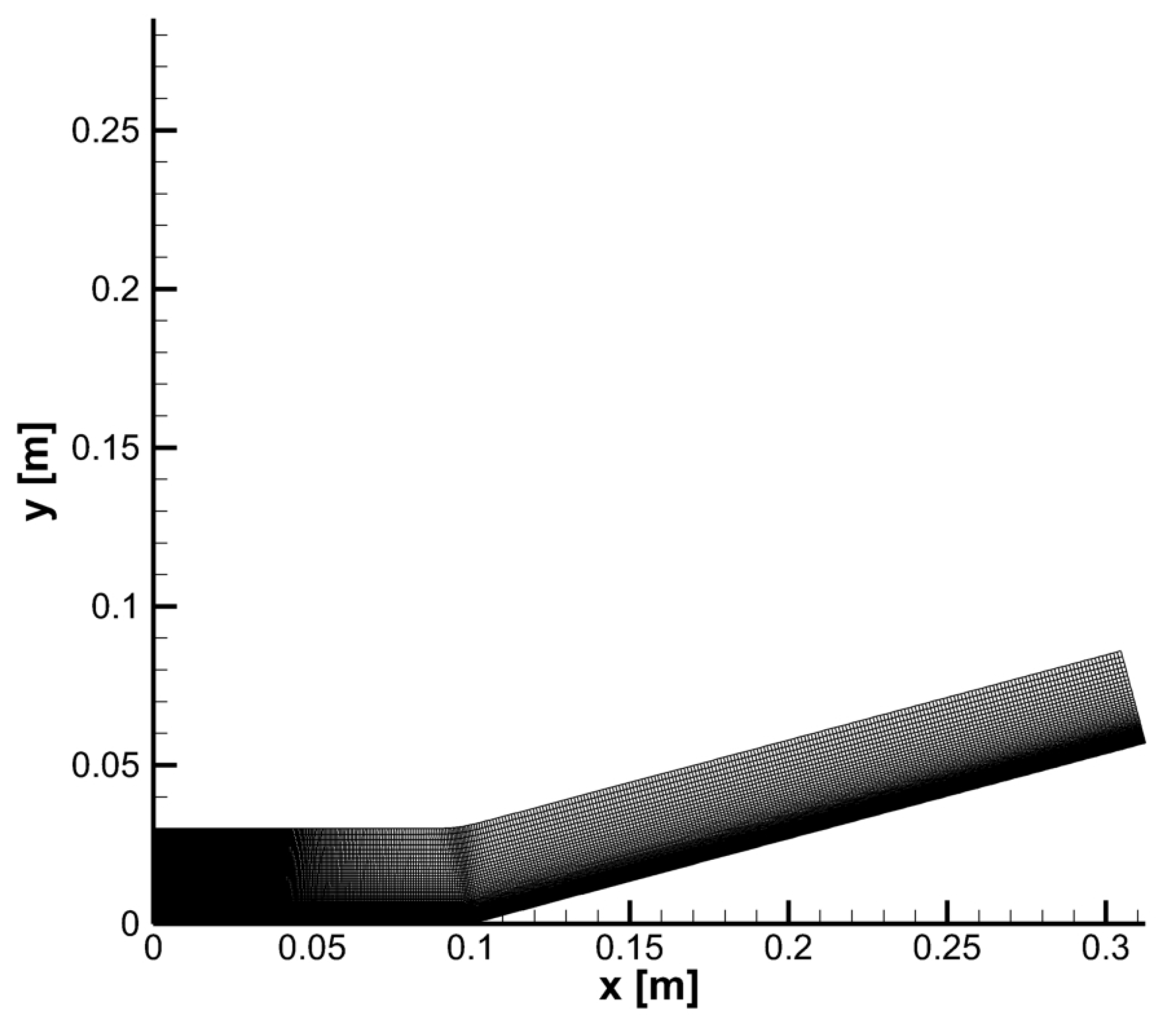
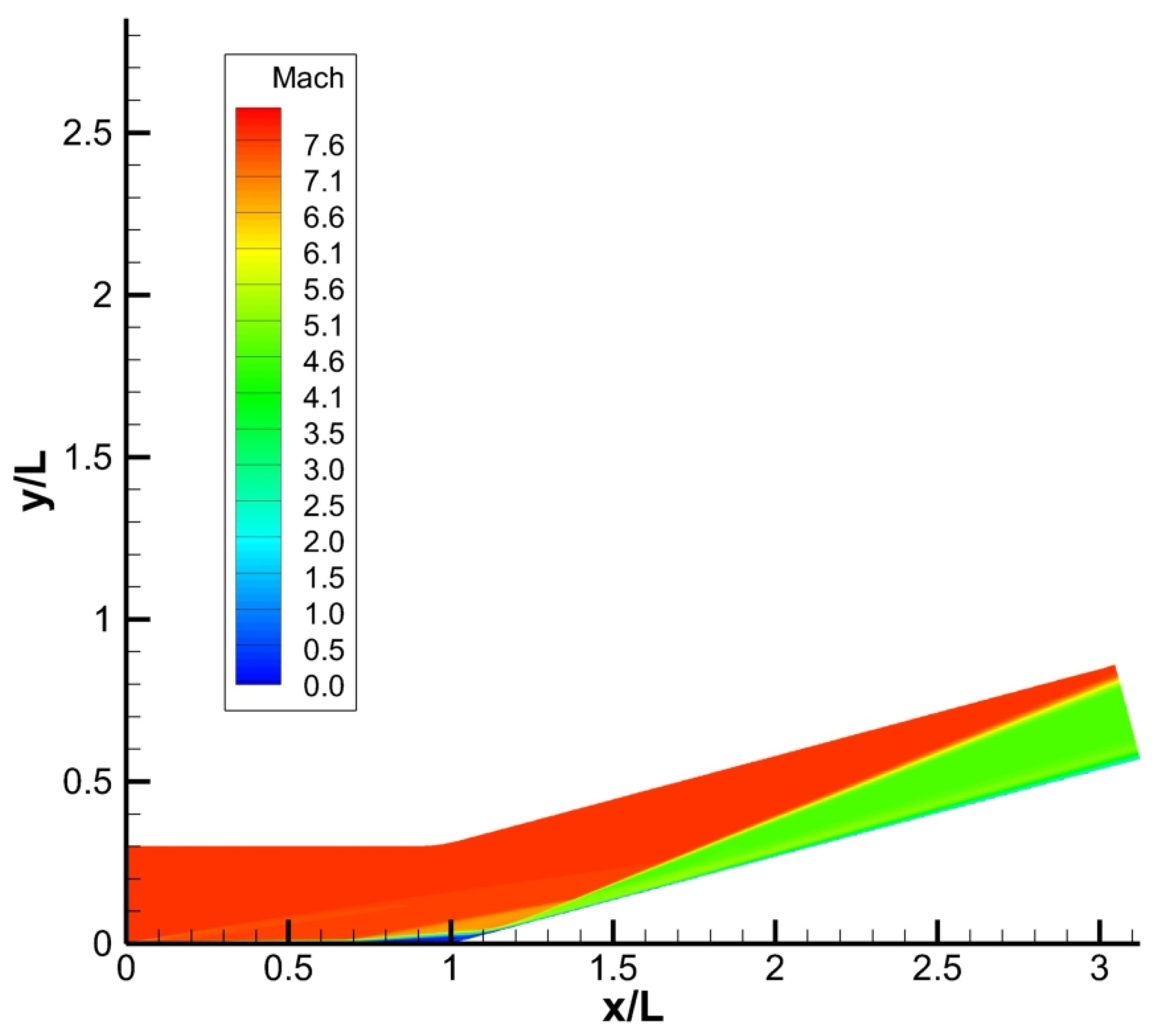
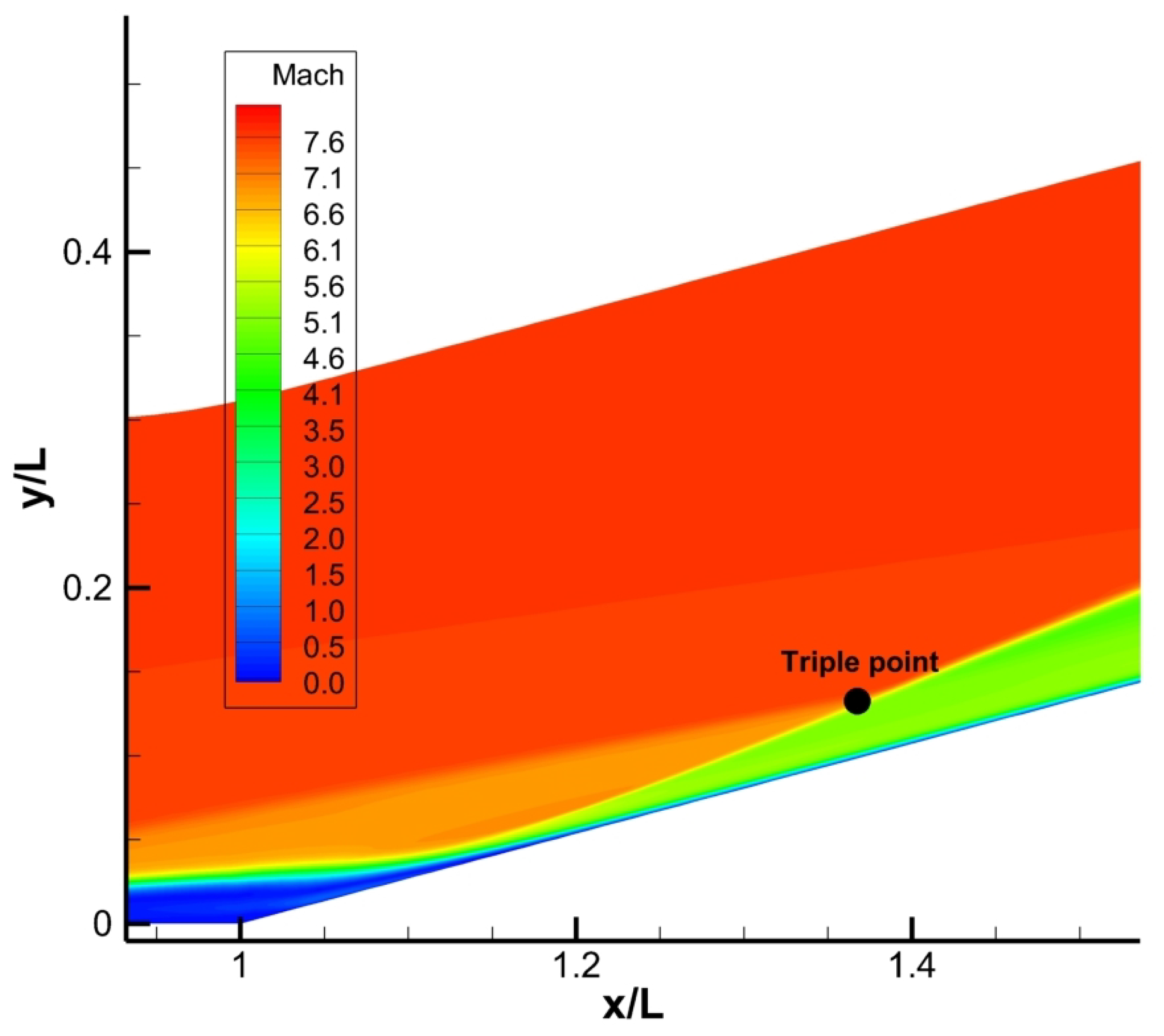
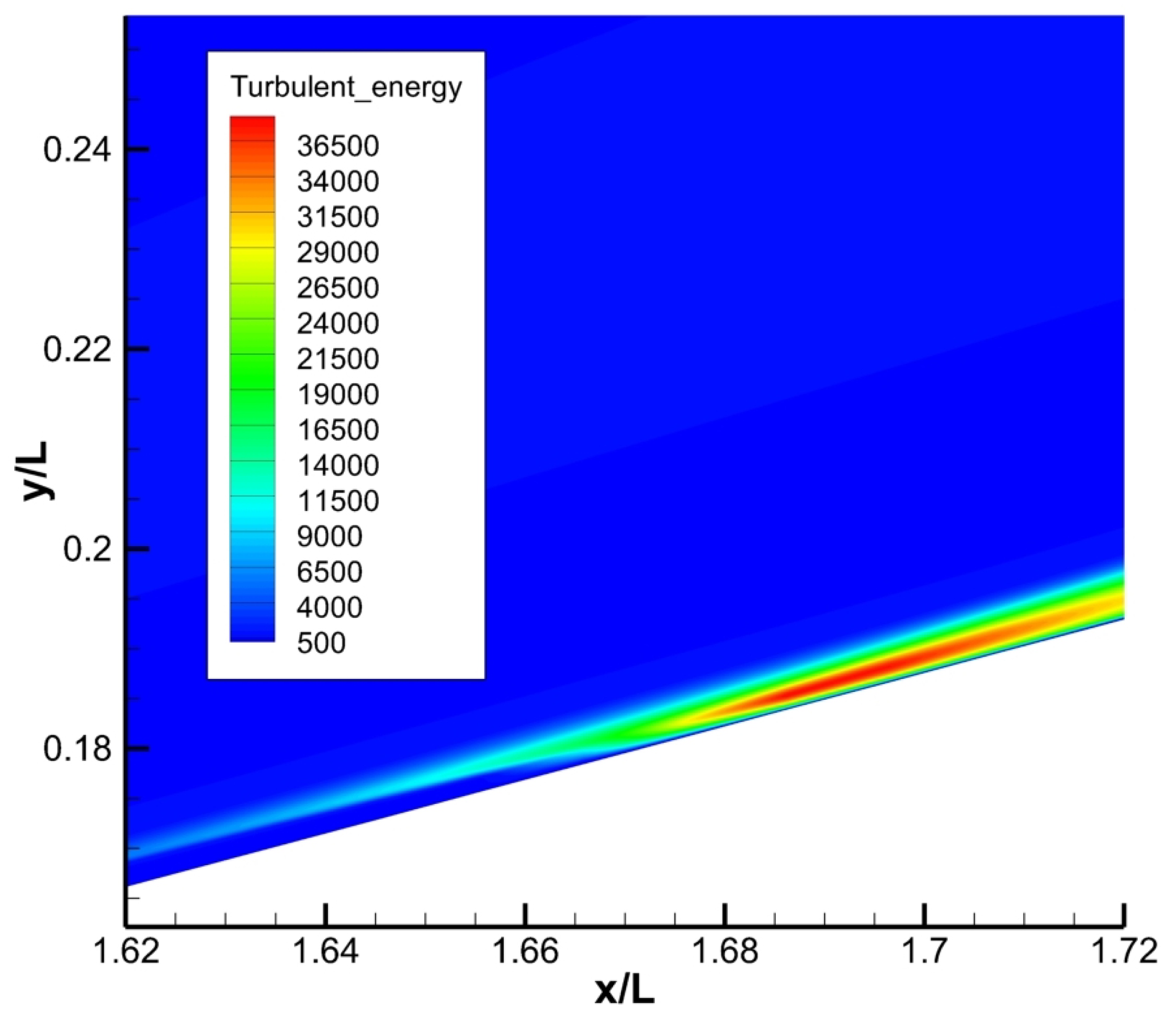
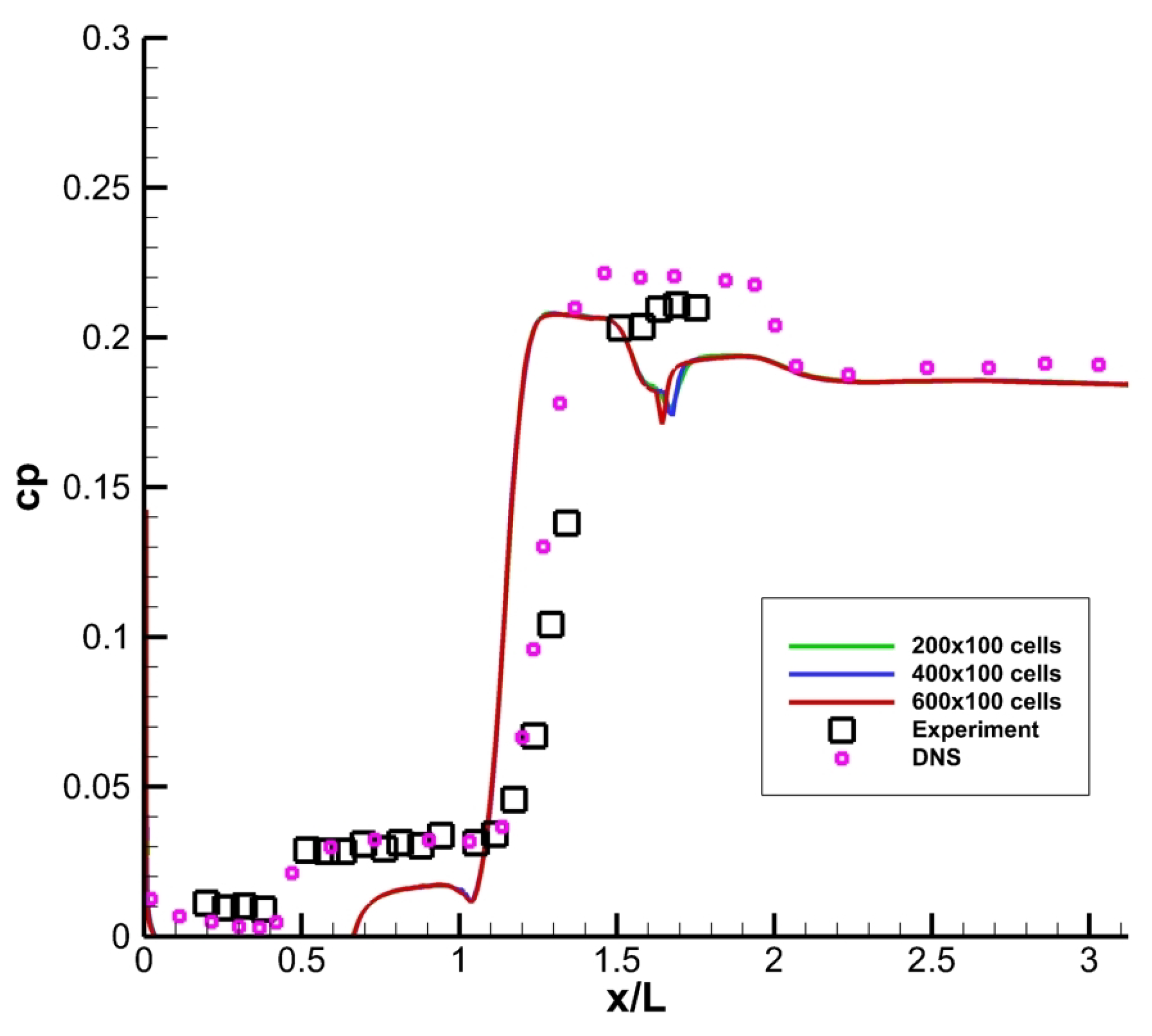
| Method | Separation | Reattachment | Triple Point | Transition |
|---|---|---|---|---|
| mod. EARSM | 0.67 | 1.17 | 1.37 | 1.67 |
| DNS | 0.49 | 1.26 | 1.65 | 1.76 |
Disclaimer/Publisher’s Note: The statements, opinions and data contained in all publications are solely those of the individual author(s) and contributor(s) and not of MDPI and/or the editor(s). MDPI and/or the editor(s) disclaim responsibility for any injury to people or property resulting from any ideas, methods, instructions or products referred to in the content. |
© 2023 by the author. Licensee MDPI, Basel, Switzerland. This article is an open access article distributed under the terms and conditions of the Creative Commons Attribution (CC BY) license (https://creativecommons.org/licenses/by/4.0/).
Share and Cite
Holman, J. Numerical Solution of Transition to Turbulence over Compressible Ramp at Hypersonic Velocity. Mathematics 2023, 11, 3684. https://doi.org/10.3390/math11173684
Holman J. Numerical Solution of Transition to Turbulence over Compressible Ramp at Hypersonic Velocity. Mathematics. 2023; 11(17):3684. https://doi.org/10.3390/math11173684
Chicago/Turabian StyleHolman, Jiří. 2023. "Numerical Solution of Transition to Turbulence over Compressible Ramp at Hypersonic Velocity" Mathematics 11, no. 17: 3684. https://doi.org/10.3390/math11173684
APA StyleHolman, J. (2023). Numerical Solution of Transition to Turbulence over Compressible Ramp at Hypersonic Velocity. Mathematics, 11(17), 3684. https://doi.org/10.3390/math11173684





